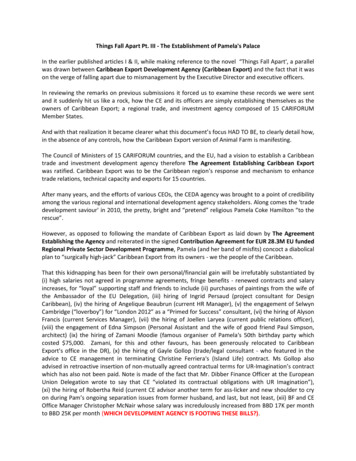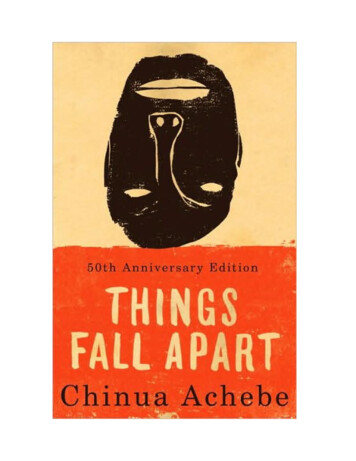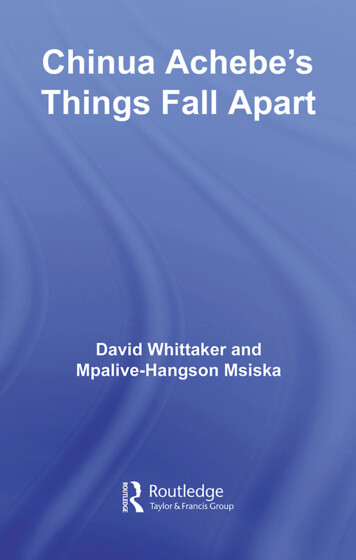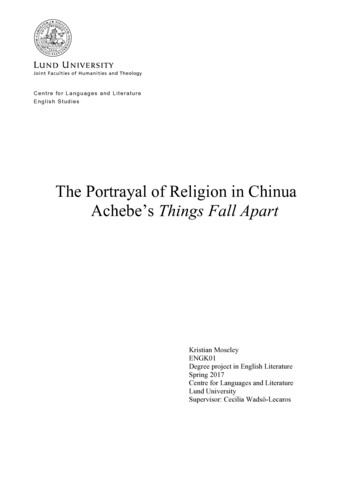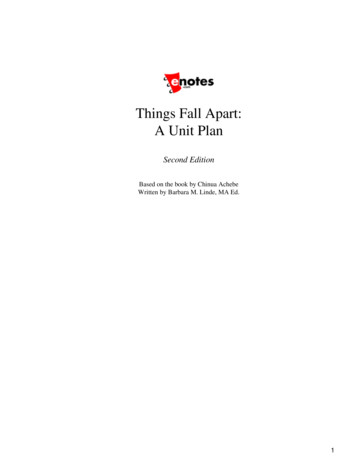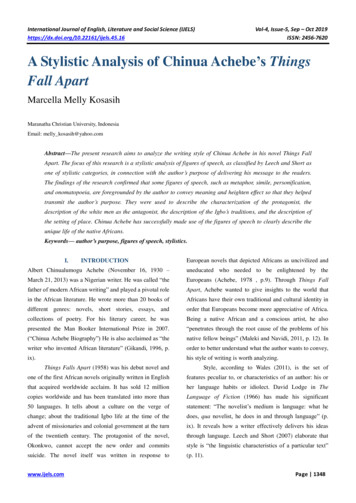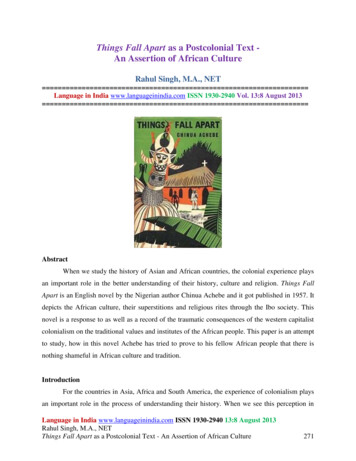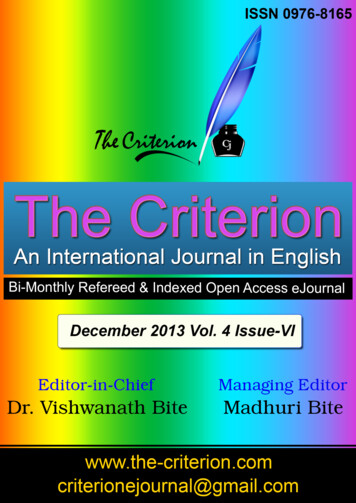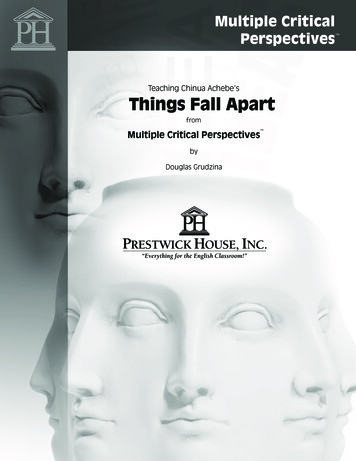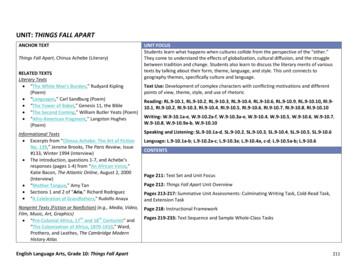
Transcription
UNIT: THINGS FALL APARTANCHOR TEXTThings Fall Apart, Chinua Achebe (Literary)RELATED TEXTSLiterary Texts “The White Man’s Burden,” Rudyard Kipling(Poem) “Languages,” Carl Sandburg (Poem) “The Tower of Babel,” Genesis 11, the Bible “The Second Coming,” William Butler Yeats (Poem) “Afro-American Fragment,” Langston Hughes(Poem)Informational Texts Excerpts from “Chinua Achebe: The Art of FictionNo. 139,” Jerome Brooks, The Paris Review, Issue#133, Winter 1994 (Interview) The introduction, questions 1-7, and Achebe’sresponses (pages 1-4) from “An African Voice,”Katie Bacon, The Atlantic Online, August 2, 2000(Interview) “Mother Tongue,” Amy Tan Sections 1 and 2 of “Aria,” Richard Rodriguez “A Celebration of Grandfathers,” Rudolfo AnayaNonprint Texts (Fiction or Nonfiction) (e.g., Media, Video,Film, Music, Art, Graphics) “Pre-Colonial Africa, 17th and 18th Centuries” and“The Colonization of Africa, 1870-1910,” Ward,Prothero, and Leathes, The Cambridge ModernHistory AtlasEnglish Language Arts, Grade 10: Things Fall ApartUNIT FOCUSStudents learn what happens when cultures collide from the perspective of the “other.”They come to understand the effects of globalization, cultural diffusion, and the strugglebetween tradition and change. Students also learn to discuss the literary merits of varioustexts by talking about their form, theme, language, and style. This unit connects togeography themes, specifically culture and language.Text Use: Development of complex characters with conflicting motivations and differentpoints of view, theme, style, and use of rhetoricReading: RL.9-10.1, RL.9-10.2, RL.9-10.3, RL.9-10.4, RL.9-10.6, RL.9-10.9, RL.9-10.10, RI.910.1, RI.9-10.2, RI.9-10.3, RI.9-10.4, RI.9-10.5, RI.9-10.6, RI.9-10.7, RI.9-10.8, RI.9-10.10Writing: W.9-10.1a-e, W.9-10.2a-f, W.9-10.3a-e, W.9-10.4, W.9-10.5, W.9-10.6, W.9-10.7,W.9-10.8, W.9-10.9a-b, W.9-10.10Speaking and Listening: SL.9-10.1a-d, SL.9-10.2, SL.9-10.3, SL.9-10.4, SL.9-10.5, SL.9-10.6Language: L.9-10.1a-b; L.9-10.2a-c; L.9-10.3a; L.9-10.4a, c-d; L.9-10.5a-b; L.9-10.6CONTENTSPage 211: Text Set and Unit FocusPage 212: Things Fall Apart Unit OverviewPages 213-217: Summative Unit Assessments: Culminating Writing Task, Cold-Read Task,and Extension TaskPage 218: Instructional FrameworkPages 219-233: Text Sequence and Sample Whole-Class Tasks211
Things Fall Apart Unit OverviewUnit Focus Topic: Culture, globalization,and languageThemes: Change versustradition and the results ofcultural collisionsText Use: Development ofcomplex characters withconflicting motivations anddifferent points of view, theme,style, and use of rhetoricSummative Unit AssessmentsA culminating writing task: Analyze how character conflicts andperspectives develop themeCompare and contrast differentinterpretations of culture byanalyzing points of view of differentcharactersA cold-read task: Read and understand grade-leveltextsWrite in response to textAn extension task: Read and cite research fromnonfiction textsApply nonfiction research to writenarrativesSynthesize and present informationfrom research and narrativesEnglish Language Arts, Grade 10: Things Fall ApartDaily TasksDaily instruction helps students read and understand textand express that understanding. Lesson 1: “The White Man’s Burden”; “Pre-Colonial Africa,17th and 18th Centuries” and “The Colonization of Africa,1870-1910,” The Cambridge Modern History Atlas (sampletasks included) Lesson 2: Chapters 1-7 of Things Fall Apart(sample tasksincluded) Lesson 3: Chapters 8-11 of Things Fall Apart Lesson 4: Chapters 12-13 of Things Fall Apart andquestions 1 (page 2), 13-14 (page 8), and 22-26 (pages 1011) and Achebe’s responses from “Chinua Achebe: The Artof Fiction No. 139” The Paris Review (sample tasksincluded) Lesson 5: The introduction, questions 1-7, and Achebe’sresponses (pages 1-4) from “An African Voice,” TheAtlantic Online Lesson 6: Chapters 14-19 of Things Fall Apart (sampletasks included) Lesson 7: Chapters 20-25 of Things Fall Apart and “TheSecond Coming” (sample tasks included) Lesson 8: Things Fall Apart (culminating writing task) Lesson 9: Question 11 and Achebe’s response (page 7)from “Chinua Achebe: The Art of Fiction No. 139,” TheParis Review (extension task) Lesson 10: “Languages” and “The Tower of Babel,”Genesis 11, the Bible (sample tasks included) Lesson 11: “Mother Tongue” Lesson 12: Pages 1-10 of “Aria” (extension task) Lesson 13: “Afro-American Fragment” and “A Celebrationof Grandfathers” (extension task)212
SUMMATIVE UNIT ASSESSMENTSCULMINATING WRITING TASK 1In a series of interviews with Jerome Brooks, Chinua Achebe says the following about Things Fall Apart: “[It]is a kind of fundamental story of my condition thatdemanded to be heard .I believe in the complexity of the human story and that there’s no way you can tell that story in one way and say, this is it. Always therewill be someone who can tell it differently depending on where they are standing .This is the way I think the world’s stories should be told—from manydifferent perspectives.”How is the human story told from a different perspective in Things Fall Apart? Determine a theme of Things Fall Apart based on the complex characters andtheir different cultural experiences and perspectives. (RL.9-10.2, RL.9-10.3, RL.9-10.6) Write a multi-paragraph essay that identifies a theme and analyzes howthat theme is shaped and refined over the course of the novel. (W.9-10.1a-e, W.9-10.4, W.9-10.5, W.9-10.10) Use proper grammar, conventions, spelling, andgrade-appropriate words and phrases. Cite several pieces of textual evidence to support the analysis, including direct quotations with page numbers. (RL.9-10.1,W.9-10.9a, L.9-10.1a-b, L.9-10.2a-c, L.9-10.3a, L.9-10.6)UNIT FOCUSUNIT ASSESSMENTWhat should students learn from the texts?What shows students have learned it?Thistask assesses: Topic: Culture, globalization, and language Themes: Change versus tradition and the Analyzing how character conflicts andresults of cultural collisionsperspectives develop theme Text Use: Development of complex Comparing and contrasting differentcharacters with conflicting motivations andinterpretations of culture by analyzingdifferent points of view, theme, style, andpoints of view of different charactersuse of rhetoric1DAILY TASKSWhich tasks help students learn it?Read and understand text: Lesson 2 (sample tasks included)Lesson 3Express understanding of text: Lesson 1 (sample tasks included)Lesson 4 (sample tasks included)Lesson 8 (use this task)Culminating Writing Task: Students express their final understanding of the anchor text and demonstrate meeting the expectations of the standards through a written essay.English Language Arts, Grade 10: Things Fall Apart213
COLD-READ TASK 2Read “Afro-American Fragment” by Langston Hughes and “A Celebration of Grandfathers” by Rudolfo Anaya independently and then answer a combination ofmultiple-choice and constructed-response questions 3 about the texts, using evidence for all answers. Sample questions:1. Identify one tone of “Afro-American Fragment.” Explain the effect of the following phrases on the tone of the poem: “words sad-sung,” “vast mist of race,”“bitter yearnings,” “Africa’s/Dark face.” (Rl.9-10.1, RL.9-10.4, L.9-10.5a-b)2. Atavistic means “relating to or reverting to something ancient or ancestral.” How do the lines “I do not understand,/This song of atavistic land,/Of bitteryearnings lost/Without a place—” develop a theme of “Afro-American Fragment”? (RL.9-10.1, RL.9-10.2, RL.9-10.4, L.9-10.4a, L.9-10.6)3. Consider the title “Afro-American Fragment.” How does the title connect to a theme of the poem? (RL.9-10.1, RL.9-10.2, RL.9-10.4, L.9-10.4a, L.9-10.5b, L.9-10.6)4. How are the grandfather’s values shaped by the setting in “A Celebration of Grandfathers”? (RI.9-10.3, RI.9-10.5)5. Compare Anaya’s grandfather when he was younger to his final days in “A Celebration of Grandfathers.” How does the explanation of Anaya’s grandfather’schanges connect to and develop a central idea of the text? (RI.9-10.2, RI.9-10.3, RI.9-10.5)6. According to “A Celebration of Grandfathers,” what does Anaya value about his grandfather? How does what he chooses to emphasize in his descriptions(e.g., author’s language, tone, etc.) reveal and develop a point of view? (RI.9-10.1, RI.9-10.4, RI.9-10.6)7. Compare the purpose in “Afro-American Fragment” with that of “A Celebration of Grandfathers.” What is the purpose of each text, and how is that purposeconveyed? According to both texts, how do people or ideas that came before (e.g., family, ancestors, language, personal history) affect a person’s identity?How do these texts support or refine themes explored in Things Fall Apart? (RL.9-10.1, RL.9-10.2, RL.9-10.3, RL.9-10.6, W.9-10.9a-b, W.9-10.10)2Cold-Read Task: Students read a text or texts independently and answer a series of multiple-choice and constructed-response questions. While the text(s) relate to the unit focus, the text(s) havenot been taught during the unit. Additional assessment guidance is available at yearassessments.3Ensure that students have access to the complete texts as they are testing.English Language Arts, Grade 10: Things Fall Apart214
UNIT FOCUSUNIT ASSESSMENTWhat should students learn from the texts?What shows students have learned it? Topic: Culture, globalization, and language This task focuses on: Themes: Change versus tradition and the Reading and understanding grade-levelresults of cultural collisionstexts Text Use: Development of complex Writing in response to textcharacters with conflicting motivations anddifferent points of view, theme, style, anduse of rhetoricEnglish Language Arts, Grade 10: Things Fall ApartDAILY TASKSWhich tasks help students learn it?Read and understand text: Lesson 5Lesson 10 (sample tasks included)Express understanding of text: Lesson 7 (sample tasks included)Lesson 13 (use this task)215
EXTENSION TASK4In an interview with The Atlantic Online, Chinua Achebe says, “There may be cultures that may sadly have to go, because no one is rooting for them, but weshould make the effort to prevent this. We have to hold this conversation, which is a conversation of stories, a conversation of languages, and see whathappens.”First, using the texts from this unit and additional information gathered from at least two credible sources through independent research, evaluate the rolelanguage plays in creating and preserving cultural identity. (RI.9-10.8, W.9-10.7, W.9-10.8, SL.9-10.2) Possible additional resources include the EndangeredLanguage Project website or the Smithsonian Department of Anthropology project, Recovering Voices: Documenting & Sustaining Endangered Languages &Knowledge.Then, create a two-part report:Part 1: Select a single word or phrase that is important to your personal history. Using Tan’s “Mother Tongue,” Rodriguez’s “Aria,” and/or Anaya’s “ACelebration of Grandfathers” as a model, write a narrative essay about the word or phrase. This should first include defining the different meanings ofthe word or phrase; identifying associations, other forms, and interpretations of the word based on your context; and explaining its history oretymology. Finally, describe in writing the impact the word or phrase has had on your life. When describing the impact, create a well-developedsequence of events, use effective narrative techniques and sensory language. (W.9-10.3a-e, W.9-10.4, W.9-10.5, W.9-10.6, W.9-10.10, L.9-10.1a-b, L.910.2a-c, L.9-10.4a-d, L.9-10.5b, L.9-10.6)Part 2: Work in a small group to create an informative multimedia product (e.g., website, video, blog, hyperlinked pamphlet, etc.) and presentation thatsynthesize and logically present the research findings and evaluations of each group member. (RI.9-10.2, W.9-10.2a-f, W.9-10.10, SL.9-10.1b, SL.9-10.4,SL.9-10.5, SL.9-10.6) Use a combination of images, graphics, and specific examples from the readings and research as support. (RI.9-10.1, W.9-10.6, W.910.9a-b) Use proper attribution to avoid plagiarism of all sources and follow MLA guidelines. (RI.9-10.1, RI.9-10.2, W.9-10.9a-b, L.9-10.3a) Effectivelydeliver the presentation and be prepared to ask and answer questions about the content of the presentation. (SL.9-10.1a, c-d; SL.9-10.4; SL.9-10.6)NOTE to Teachers: This task is first introduced in Lesson 9 and continues through Lesson 12. There are additional activities in each lesson below that helpstudents complete this task. They include: 4Lesson 9: Extension task is introduced. Students write an initial reflection that they come back to as they read and discuss more content.Lesson 10: Students read and comprehend two new texts and compare them to the anchor text. Students refine their initial extension task reflection.Lesson 11: Students read and comprehend “Mother Tongue.” Students refine their extension task reflection.Lesson 12: Students read and comprehend excerpts of “Aria.” Students refine their extension task reflection and complete all task sections.Extension Task: Students connect and extend their knowledge learned through texts in the unit to engage in research or writing. The research extension task extends the concepts studied in theset so students can gain more information about concepts or topics that interest them. The writing extension task either connects several of the texts together or is a narrative task related to theunit focus.English Language Arts, Grade 10: Things Fall Apart216
UNIT FOCUSWhat should students learn from the texts? Topic: Culture, globalization, and language Themes: Change versus tradition and theresults of cultural collisions Text Use: Development of complexcharacters with conflicting motivations anddifferent points of view, theme, style, anduse of rhetoricUNIT ASSESSMENTDAILY TASKSWhat shows students have learned it?This task focuses on:Which tasks help students learn it?Read and understand text: English Language Arts, Grade 10: Things Fall ApartReading and citing research fromnonfictionApplying nonfiction research to writingnarrativesSynthesizing and presenting informationfrom research and narrativesLesson 6 (sample tasks included)Lesson 10 (sample tasks included)Express understanding of text: Lesson 9 (use this task)Lesson 11 (use this task)Lesson 12 (use this task)217
INSTRUCTIONAL FRAMEWORKIn English language arts (ELA), students must learn to read, understand, and write and speak about grade-level texts independently. To do this, teachers must selectappropriate texts and use those texts so students meet the standards, as demonstrated through ongoing assessments. To support students in developing independencewith reading and communicating about complex texts, teachers should incorporate the following interconnected components into their instruction.Click here 5 to locate additional information about this interactive framework.Whole-Class InstructionThis time is for grade-level instruction. Regardless of a student’s reading level, exposure to grade-leveltexts supports language and comprehension development necessary for continual reading growth. Thisplan presents sample whole-class tasks to represent how standards might be met at this grade level.Small-Group ReadingThis time is for supporting student needs that cannot be met during whole-class instruction. Teachersmight provide:1. intervention for students below grade level using texts at their reading level;2. instruction for different learners using grade-level texts to support whole-class instruction;3. extension for advanced readers using challenging texts.Small-Group WritingMost writing instruction is likely to occur during whole-class time. This time is for supporting studentneeds that cannot be met during whole-class instruction. Teachers might provide:1. intervention for students below grade level;2. instruction for different learners to support whole-class instruction and meet grade-level writingstandards;3. extension for advanced writers.Independent ReadingThis time is for increasing the volume and range of reading that cannot be achieved through other instruction but is necessary for student growth. Teachers can:1. support growing reading ability by allowing students to read books at their reading level;2. encourage reading enjoyment and build reading stamina and perseverance by allowing students to select their own texts in addition to teacher-selected lesson-assessment-planning-resourcesEnglish Language Arts, Grade 10: Things Fall Apart218
TEXT SEQUENCE AND SAMPLE WHOLE-CLASS TASKSTEXT SEQUENCELESSON 1:6“The White Man’s Burden,”Rudyard Kipling“Pre-Colonial Africa, 17th and 18thCenturies” and “The Colonizationof Africa, 1870-1910,” Ward,Prothero, and Leathes, TheCambridge Modern History AtlasTEXT USETEXT DESCRIPTION: Rudyard Kipling is widely considered “Britain’s imperialist poet.” “The White Man’s Burden”encouraged President Roosevelt and the United States to fight for control of the Philippines in 1899. The poemcontains a potentially offensive point of view if students do not understand the historical context of the poem. Providestudents with the prefacing information on the History Matters 7 site to support this. The maps provide a visual imageof the changes in Africa due to European imperialism.TEXT FOCUS: “The White Man’s Burden” provides opportunities for analyzing a point of view reflected in a work fromoutside the United States. (RL.9-10.6) Students determine the meaning of words and phrases and analyze their impacton the meaning and the tone of the poem. (RL.9-10.4) The brief background information for each map provideshistorical context for the visuals, but should not be shared until after students have had a chance to explore the maps,make comparisons, and draw conclusions (including information gained from the poem) about the cause-and-effectrelationships that resulted in the changes. (SL.9-10.2)MODEL TASKSLESSON OVERVIEW: Students read background knowledge about imperialism and then work in pairs to read a poemand view maps that relate to the content of the poem. Then students participate in a discussion and write a responsebased on the question in the discussion.READ AND UNDERSTAND THE TEXTS:67 Read aloud the introduction to “The White Man’s Burden” as students follow along. Define the wordimperialism as a class. Have students work in pairs to create a written summary of the context of the poem.(RI.9-10.2, W.9-10.10) Have each pair share their summary with the class. (SL.9-10.1a-b, SL.9-10.4) Clear upany misunderstandings or misconceptions prior to reading the poem. Have students read “The White Man’s Burden” in pairs and circle words and phrases that reveal the speaker’sattitude or point of view. Reread the identified words and phrases to determine the tone of the poem. Whatpoint of view does this poem convey? (RL.9-10.4, RL.9-10.6, L.9-10.5a-b)Note: One lesson does not equal one day. Teachers should determine how long to take on a given lesson. This will depend on each unique class.http://historymatters.gmu.edu/d/5478/English Language Arts, Grade 10: Things Fall Apart219
TEXT SEQUENCETEXT USE Have students work in pairs to view the maps using the Library of Congress Analysis Tool for Maps. Thisteacher’s guide8 provides analysis questions and the Primary Source Analysis Tool 9 (PDF version 10) providesspace for students to record their analysis. Students should complete this analysis prepared to explain whatspecific changes in Africa happened prior to and after the colonization that occurred between 1870 and 1910.EXPRESS UNDERSTANDING:LESSON 2:Chapters 1-7 of Things Fall Apart,Chinua Achebe Prompt students to reread “The White Man’s Burden” independently and determine how the point of viewexpressed in the poem corroborates the changes seen in the maps. (RL.9-10.6, RI.9-10.7) Conduct a discussionbased on the following question: “What do these texts convey about the relationship between Europeans andAfricans?” (SL.9-10.1a, c-d; SL.9-10.4; SL.9-10.6) Cite specific textual evidence from both sources and identifywhich details are emphasized in the different texts (poem and maps). (RL.9-10.1) Conclude the discussion by asking students to independently write a response in answer to the discussionquestion above. (RL.9-10.1, RL.9-10.6, RI.9-10.7, W.9-10.2a-b, W.9-10.9a-b, W.9-10.10) Note for Small-Group Writing: In all written responses, require students to use parallel structure, varioustypes of phrases, and compound sentences joined by semicolons and conjunctive adverbs in order tostrengthen the quality of their writing. Students began this work in grade 9, so additional support in doing thiscorrectly can be based on individual student weaknesses as seen through their writing samples. Supportstudents through mini-lessons using student writing samples, peer editing, and teacher-student conferences.(L.9-10.1a-b, L.9-10.2a)TEXT DESCRIPTION: Chapters 1-7 of Things Fall Apart establish the major characters of the text and theirmotivations. They also introduce the Igbo culture and themes of the novel. The novel’s style is easy to read but willpresent challenges to students because of the cultural experiences Achebe presents. Students will need to discuss andexplore the meaning conveyed by the information provided.TEXT FOCUS: Students read and discuss key ideas and details, including the development of Okonkwo’s character andinternal conflicts and various themes. (RL.9-10.2, RL.9-10.3) Okonkwo’s character is illustrated through a narrator’slimited omniscient point of ces/resources/Analyzing primarysources/resources/Primary Source Analysis Tool.pdf9English Language Arts, Grade 10: Things Fall Apart220
TEXT SEQUENCEMODEL TASKSTEXT USELESSON OVERVIEW: Read the first chapter aloud and have the students read the rest independently. Students identifycharacters and their interactions. Students discuss and write about the main character’s developing point of view.READ THE TEXT: Read the first chapter aloud with students as they follow along. Answer any questions or address confusionabout the cultural differences presented in the text. Have students read the remaining chapters in small groups. (RL.9-10.10) Have students reread sections and, in journals or reading logs, summarize character interactions and the plotof the novel based on the following sections. Students should create a graphic organizer with three columns.The first should say “text section,” the second “key character interactions,” and the third “key events.” In eachcolumn, students should summarize key pieces of information for the chapters below and cite the associatedtext references. (RL.9-10.2, W.9-10.10)oooooChapter 1: the characterization of Unoka, Okonkwo’s fatherChapter 2: the last part of the chapter, beginning with “Okonkwo ruled his house with a heavy hand”Chapter 4: the first two paragraphsChapter 5: Okonkwo’s outburst with his gunChapter 7: Ikemefuna’s murderUNDERSTAND THE TEXT:11 Have students swap their charts with a partner to provide feedback. Prompt students to make revisions totheir summaries based on the peer feedback. (RL.9-10.2, W.9-10.5, W.9-10.10) In pairs, have students determine a point of view that is representative of the Igbo culture and examine howAchebe establishes that point of view through his language, story elements (e.g., characters, conflicts, setting,plot details), selecting quotations from the text that support the identified point of view. (RL.9-10.3, RL.9-10.4) Using accountable talk, 11 discuss as a class how the point of view they determined compares to points of viewin Western cultures. (RL.9-10.6, SL.9-10.1a, SL.9-10.6) Conclude by creating a class list of the Igbo people’svalues. Ask students to cite evidence to support their interpretations. (RL.9-10.1, RL.9-10.4, sEnglish Language Arts, Grade 10: Things Fall Apart221
TEXT SEQUENCE TEXT USEHave students create a graphic organizer with three columns that (1) identify and describe the majorcharacters of the novel, including labeling them as either a protagonist or antagonist, (2) determine eachcharacter’s motivations as revealed through their interactions with each other and their environment, and (3)use words, phrases, and quotations from the text as support. (RL.9-10.1, RL.9-10.3, RL.9-10.4) Students willcome back to this graphic organizer throughout the reading of the novel. Be sure they create it in journals thatare easily accessible for the remainder of the unit.EXPRESS UNDERSTANDING: LESSON 3:Chapters 8-11 of Things Fall Apart,Chinua AchebeHave students work in pairs to write a response to the following questions: How do Okonkwo’s thoughts andactions convey his motivations? How do Okonkwo’s motivations establish a theme of the novel? (RL.9-10.1,RL.9-10.2, RL.9-10.3, W.9-10.1a-c, W.9-10.9a, W.9-10.10)TEXT DESCRIPTION: Chapters 8-11 of Things Fall Apart continue to develop Okonkwo’s character and his conflictingmotivations. As his character develops, students begin to understand how the Igbo culture causes some of his internalconflict and how individuals are shaped by the culture in which they live. Okonkwo’s relationship with Ezinma, hisfavorite daughter, emerges and shapes some of the themes of the novel while Nwoye, his son, develops into a morecomplex, conflicted character.TEXT FOCUS: The first two pages of Chapter 8 (Okonkwo’s reaction to Ikemefuna’s death) and the first paragraph ofChapter 9 are suitable for students to summarize and to continue completing the graphic organizer begun in Lesson 2.Encourage students to consider why Achebe might include the events of these chapters. Focus students on discussingand analyzing in writing how Okonkwo’s complex reactions to Ikemefuna’s death enhance their understanding of hischaracter: How does Okonkwo’s reaction reveal his internal conflicts and develop a theme established in Chapters 1-7?(RL.9-10.2, RL.9-10.3) Students might be confused by the events surrounding Ezinma’s illness. Support theirunderstanding by asking them to consider what Okonkwo’s relationship with Ezinma reveals about Okonkwo’scharacter and the Igbo culture. In addition, ask them to explain how Okonkwo’s reaction to Ekwefi’s concern developsa theme established in Chapters 1-7. Use this information to add to the class list begun in Lesson 2.LESSON 4:Chapters 12-13 of Things Fall Apart,Chinua AchebeTEXT DESCRIPTION: Chapters 12 and 13 of Things Fall Apart build to a climactic event in which Okonkwo’s usuallyimpotent gun discharges and kills a tribe member. The symbolic nature of this event and the resulting exile arepowerful methods for helping students understand the complexity of the Igbo culture. The excerpt from The ParisReview illustrates Achebe’s views on the interactions between character, plot, and theme.TEXT FOCUS: Students may impose Western ideology onto the Igbo people, which can result in confusion aboutQuestions 1 (page 2), 13-14 (pageOkonkwo’s accident and resulting banishment. The interview serves as a way to better understand the Igbo people so8), and 22-26 (pages 10-11) andstudents can make meaning of the events in these chapters.Achebe’s responses from “ChinuaEnglish Language Arts, Grade 10: Things Fall Apart222
TEXT SEQUENCEAchebe: The Art of Fiction No.139,” Jerome Brooks, The ParisReview, Issue #133, Winter 1994(Interview)MODEL TASKSTEXT USELESSON OVERVIEW: Students read Chapters 12-13 of Things Fall Apart independently. Read the interview sections as aclass. Discuss key connections and have students complete the lesson with a brief timed written response.READ AND UNDERSTAND THE TEXT: Have students read the chapters independently during or outside of class. As a class, evaluate Achebe’s intentions, using the class list begun in Lesson 2 and Achebe’s responses in theinterview. Focus students on summarizing Achebe’s responses to question 13, “Can you say something aboutthe germination of a work ” and question 14, “What is the place of plot.” These sections prompt students toconsider how the character and plot in Things Fall Apart interact to convey a theme or central idea.Additionally, the short dialogue (questions 22-26 and Achebe’s responses) illustrates the effect of Okonkwo’scharacter on readers. A rich examination of global themes in literature arises from the second excerpt. Help students makeconnections to other works they have studied or read independently. (RI.9-10.10)EXPRESS UNDERSTANDING:LESSON 5:The introduction, questions 1-7,and Achebe’s responses (pages 1-4)from “An African Voice,” KatieBacon, The Atlantic Online, August2, 2000 (Interview)12 Conduct a discussion in which students use accountable talk 12 and discuss how Okonkwo’s motivations andactions develop the plot and themes of the novel. (RL.9-10.2, RL.9-10.3, SL.9-10.1a, SL.9-10.6) Ensure studentscite specific textual evidence from the novel and the interview to support their responses. (RL.9-10.1) Following the fishbowl discussions, have students write a brief timed analysis of the question above. (RL.910.1, RL.9-10.2, W.9-10.1a-e, W.9-10.9a-b, W.9-10.10)TEXT DESCRIPTION: The excerpts from “An African Voice” provide students with Achebe’s point of view about “theprocess of ‘re-storying’ peoples who had been knocked silent by all kinds of dispossession.”TEXT FOCUS: Students are better equipped to read and analyze Chapters 14-19 of Things Fall Apart if they develop anunderstanding of Achebe’s point of view and purpose for writing the novel. Students read and summarize theinterview an
Things Fall Apart 214. COLD-READ TASK. 2. Read " Afro-American Fragment " by Langston Hughes and " A Celebration of Grandfathers " by Rudolfo Anaya independently and the. n answer . a combination of multiple-choice and constructed-response questions. 3. about the texts, using evidence for all answers. Sample questions: 1.
